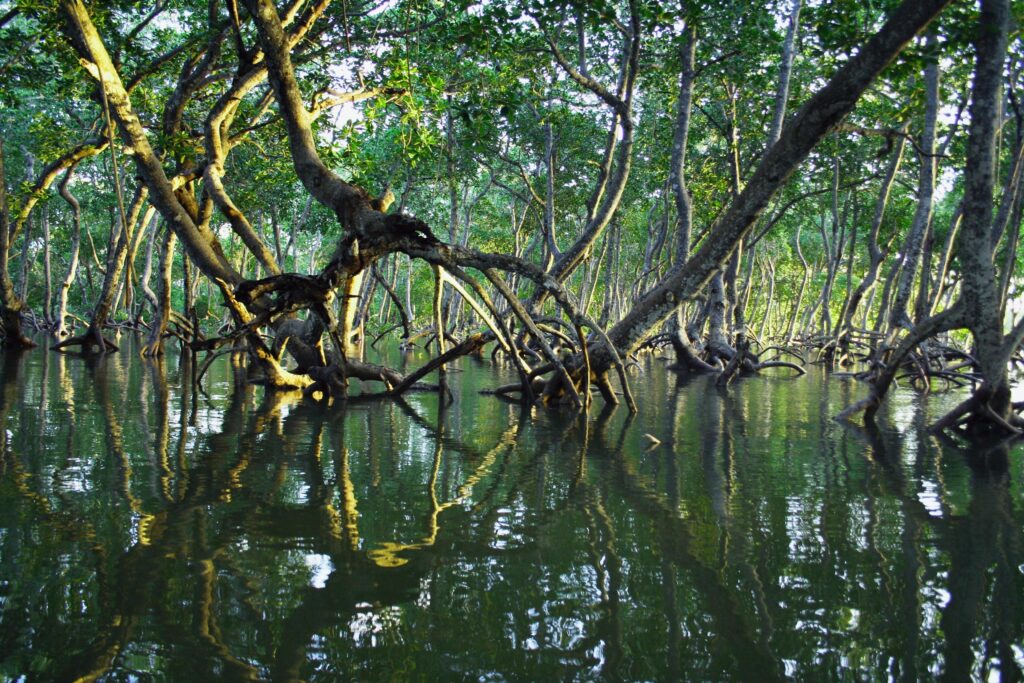Mangroves represent a distinctive group of tropical trees or shrubs that flourish in challenging coastal ecosystems, especially in regions characterized by salty or brackish waters. These plants exhibit remarkable adaptations that allow them to flourish in challenging environments.
- Salt tolerance: Mangroves possess specialized mechanisms that allow them to filter excess salt from the water they absorb, facilitating their growth in saline environments.
- Aerial Roots: Numerous species exhibit the development of aerial roots that extend above the waterline, facilitating their access to oxygen in waterlogged soils.
- Prop Roots: Some mangrove species develop prop roots that extend from their trunks and branches, offering enhanced stability in soft, muddy environments.
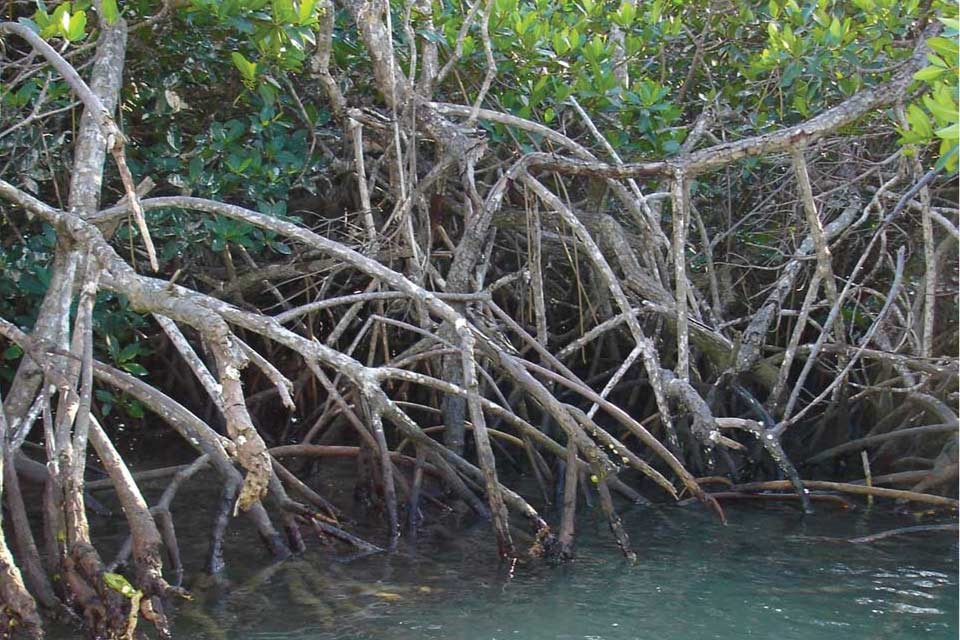
Figure 1: Mangrove forest, adapted from https://oceanservice.noaa.gov/facts/mangrove-forest.jpg
Mangroves are essential components of coastal ecosystems, offering habitats for a variety of marine species, safeguarding shorelines against erosion, and contributing to carbon sequestration. Local communities gain advantages through the provision of resources like timber, food, and medicine.
Table of Contents
ToggleMangrove Vegetation
Mangrove vegetation consists of a unique assemblage of salt-tolerant trees and shrubs that thrive in the intertidal zones of tropical and subtropical coastlines. Mangrove vegetation refers to the plant species that dominate mangrove ecosystems. These include trees such as the red mangrove (Rhizophora mangle), black mangrove (Avicennia germinans), and white mangrove (Laguncularia racemosa), as well as various shrubs, grasses, and herbs. These plants display remarkable adaptations to:
- Thrive in saline water environments.
- Tolerate variations in tidal levels.
- Flourish in soils with low oxygen availability. The combination of these adaptations results in a distinct ecosystem referred to as a mangrove forest.
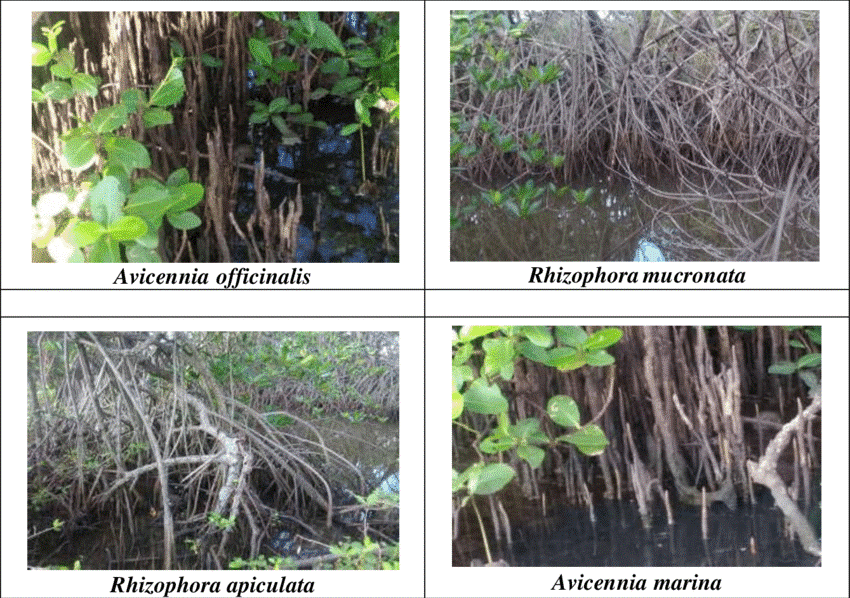
Figure 2: Root system of mangrove forest. Source: https://www.researchgate.net/profile
- Red mangrove (Rhizophora mangle), with its distinctive stilt roots that stabilize the soil.
- Black mangrove (Avicennia germinans), characterized by pneumatophores (aerial roots) that help the plant breathe in oxygen-poor environments.
- White mangrove (Laguncularia racemosa), which thrives in areas with less tidal influence and filters salt through its roots.
- Buttonwood mangrove (Conocarpus erectus), which is more tolerant of freshwater and less saline conditions.
Understanding Mangrove Ecology & Key factors
The study of mangrove ecosystems involves examining the complex interactions among plants, animals, and their surrounding environment. This analysis explores the functioning, adaptation, and contributions of these ecosystems to biodiversity and human well-being.
- Important factors of Mangrove Ecology:
- Physiological Adaptations:Mechanisms for salt filtration. Specialized root systems for oxygen absorption. Water-mediated seed distribution.
- Biodiversity and Food Webs: Mangroves provide habitat for a variety of life forms, encompassing fish, crustaceans, birds, and others. These ecosystems establish intricate food webs, facilitating the transfer of energy and nutrients among various species.
- Ecosystem Services:
- Coastal protection:
- Carbon sequestration.
- Nursery habitats for marine organisms.
- Water filtration.
- Mangroves provide numerous essential services, such as coastal protection, carbon sequestration, water filtration, and nursery habitats for marine life. Mangrove ecology assesses the value of these services and their contribution to human well-being.
- Threats and Conservation:
Mangrove forests are facing threats from human activities such as deforestation, pollution, and climate change. Mangrove ecology plays a crucial role in understanding these threats, developing conservation strategies, and restoring degraded mangrove ecosystems.
By studying mangrove ecology, scientists gain a deeper understanding of these unique ecosystems and their importance for the health of our planet which is essential for effective conservation and sustainable management of mangrove resources.
- Key Characteristics of Mangrove Ecosystems
- Salt Tolerance: Adaptations including roots that filter salt and glands that excrete salt.
- Tidal Influence: Nutrients introduced by tidal movements enhance soil oxygenation.
- Complex Root Structures: Secure mangroves in soft substrates and reinforce coastal boundaries.
- Substantial Biodiversity: This area supports a wide range of species, encompassing fish, invertebrates, birds, and reptiles.
The Importance of Mangrove Ecosystems in Ecology
Mangrove ecosystems play a vital role for the environment and human communities:
- Coastal Protection: They serve as natural defenses against erosion, storm surges, and tsunamis.
- Carbon Sequestration: Mangroves play a crucial role in capturing and storing atmospheric carbon dioxide, contributing significantly to efforts in climate change mitigation.
- Nursery Grounds: Serve as essential environments for young fish and invertebrates, contributing to fisheries and ensuring food security.
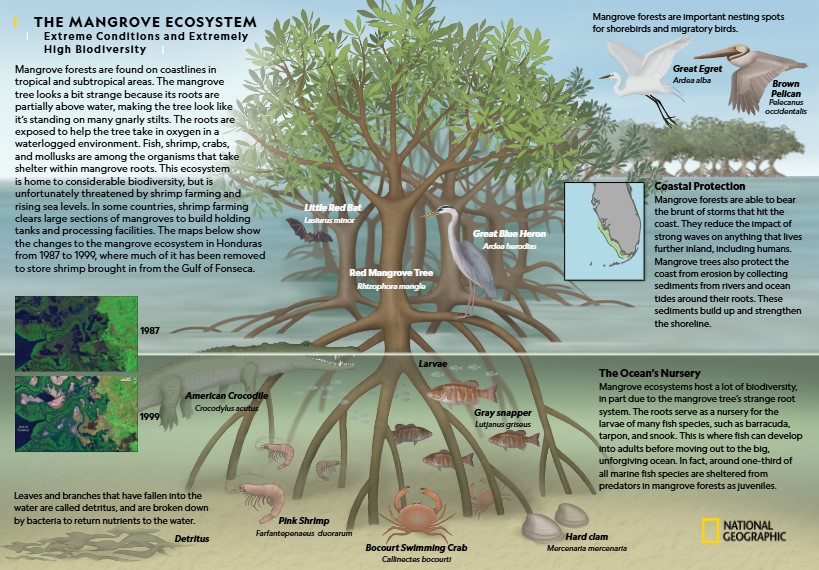
Figure 3: Mangrove ecosystem adopted from https://www.nationalgeographic.org/
- Water Filtration: Enhance water quality through the capture of pollutants and sediments.
- Biodiversity: Mangrove forests support a wide array of species, many of which face endangerment or threat.
Threat-Facing Mangrove Ecosystems
Despite their critical role, mangroves encounter considerable challenges, such as:
- Coastal Development: The clearing of mangrove forests occurs for purposes such as aquaculture, agriculture, and urban expansion.
- Pollution: The degradation of water quality and harm to mangroves is caused by industrial and agricultural runoff.
- Climate Change: Increasing sea levels and more frequent extreme weather events threaten mangrove ecosystems.
- Overexploitation: The unsustainable extraction of timber and other resources adversely affects these ecosystems.
- Invasive species: Non-native plants and animals can outcompete native mangrove species, disrupting the ecosystem’s balance and function.
The efforts that can be taken for the Conservation of mangroves Conservation Efforts:
- Protected Areas: Creating marine protected zones to ensure the preservation of habitats.
- Sustainable Management: Adopting practices in forestry and aquaculture that reduce environmental impacts.
- Restoration Projects: Initiatives focused on reforesting and revitalizing degraded mangrove ecosystems.
- Community Involvement: Engaging local populations in conservation efforts to ensure sustainable outcomes.
Understanding the significance of mangroves and implementing measures for their conservation allows us to safeguard their essential roles in the ecosystem and human communities.
Chart: Ecological Importance and Threats
| Ecological Importance | Threats |
| Coastal Protection: Shields against erosion, storm surges, and tsunamis | Coastal Development: Clearing for aquaculture, agriculture, and urbanization |
| Carbon Sequestration: Captures and stores carbon dioxide | Pollution: Industrial and agricultural runoff harming water quality |
| Nursery Grounds: Habitats for juvenile fish and marine life | Climate Change: Rising sea levels and extreme weather events |
| Water Filtration: Improves water quality by trapping pollutants | Over exploitation: Unsustainable harvesting of resources |
| Biodiversity: Supports a wide range of plant and animal life | Deforestation: Conversion of mangrove forests to other land uses |
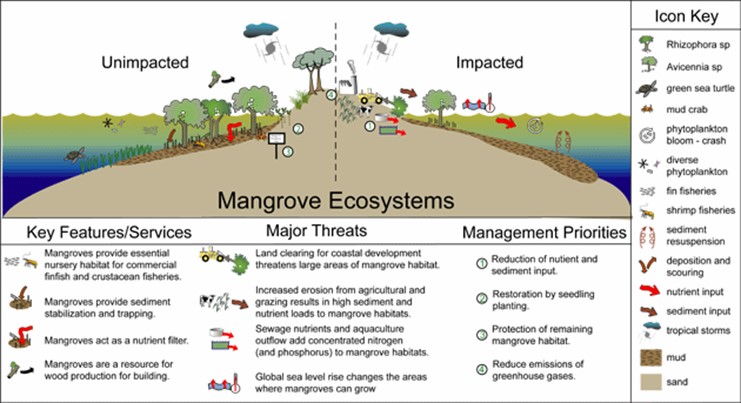
Figure 4: Threat of mangrove forest (Sundarbans) adapted from https://sundarbanmangroves.wordpress.com
